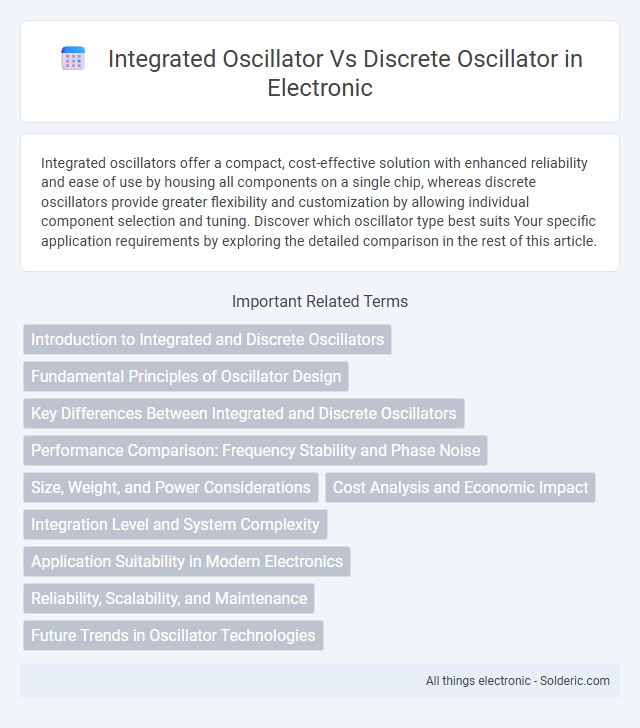Integrated oscillators offer a compact, cost-effective solution with enhanced reliability and ease of use by housing all components on a single chip, whereas discrete oscillators provide greater flexibility and customization by allowing individual component selection and tuning. Discover which oscillator type best suits Your specific application requirements by exploring the detailed comparison in the rest of this article.
Comparison Table
| Feature | Integrated Oscillator | Discrete Oscillator |
|---|---|---|
| Component Type | All components on a single IC | Separate individual components |
| Size | Compact, small footprint | Larger, depends on component arrangement |
| Frequency Stability | Moderate, good for general use | High, customizable for precision |
| Power Consumption | Lower power consumption | Usually higher power consumption |
| Cost | Generally cheaper in mass production | Higher initial cost due to components |
| Flexibility | Limited tuning options | Highly customizable frequency and waveform |
| Applications | Consumer electronics, simple timing circuits | High precision timing, RF circuits, lab equipment |
Introduction to Integrated and Discrete Oscillators
Integrated oscillators feature compact designs with transistors and passive components fabricated on a single silicon chip, offering enhanced stability and lower power consumption. Discrete oscillators consist of individually packaged components like quartz crystals, capacitors, and inductors assembled on a circuit board, allowing greater flexibility in frequency selection and customization. Integrated oscillators are preferred in modern compact devices, while discrete oscillators remain essential in applications requiring high precision and low phase noise.
Fundamental Principles of Oscillator Design
Integrated oscillators utilize on-chip components such as capacitors, inductors, and transistors to achieve frequency stability and compactness, relying on feedback loops within semiconductor materials. Discrete oscillators employ separate, external components that offer flexibility in tuning and potentially higher Q-factors, impacting phase noise and signal purity. Your choice depends on application requirements like size, power consumption, and frequency precision, as each design principle affects performance characteristics uniquely.
Key Differences Between Integrated and Discrete Oscillators
Integrated oscillators combine all components on a single semiconductor chip, offering compact size, lower cost, and higher reliability due to reduced parasitic elements. Discrete oscillators use separate components like crystals, capacitors, and inductors, providing greater flexibility in frequency selection and performance tuning but at the cost of larger size and potentially higher noise. Integrated oscillators excel in mass-produced electronics requiring stability and integration, while discrete oscillators are preferred in applications demanding precise frequency control and customization.
Performance Comparison: Frequency Stability and Phase Noise
Integrated oscillators generally offer superior frequency stability due to their monolithic construction, which minimizes environmental variations such as temperature fluctuations and mechanical vibrations. Discrete oscillators can achieve lower phase noise through the use of specialized, high-quality external components and careful circuit design, but they may suffer from greater susceptibility to external interference. Choosing between the two involves balancing integrated oscillators' consistent frequency stability with discrete oscillators' potential for enhanced phase noise performance depending on application requirements.
Size, Weight, and Power Considerations
Integrated oscillators offer significant advantages in size, weight, and power (SWaP) compared to discrete oscillators, as they combine all necessary components on a single chip, drastically reducing the overall footprint. Your design benefits from lower power consumption and lighter weight, crucial for portable and space-constrained applications. Discrete oscillators, while potentially offering higher performance tuning options, generally consume more power and increase system complexity and weight due to separate components.
Cost Analysis and Economic Impact
Integrated oscillators offer significant cost savings compared to discrete oscillators due to reduced component count and simplified assembly processes. Your projects benefit from lower manufacturing expenses and improved reliability, which decrease long-term maintenance costs. Economically, integrated oscillators enable scalable production and enhanced market competitiveness through cost-effective design and streamlined supply chains.
Integration Level and System Complexity
Integrated oscillators feature a high level of integration, combining active and passive components on a single chip, which significantly reduces system complexity and board space requirements. Discrete oscillators rely on separate, individual components such as external capacitors, inductors, and transistors, leading to increased circuit complexity, larger footprint, and more intricate assembly processes. The higher integration in integrated oscillators enhances reliability and simplifies design, while discrete oscillators offer flexibility in component selection and tuning but at the cost of greater system complexity.
Application Suitability in Modern Electronics
Integrated oscillators offer superior application suitability in modern electronics due to their compact size, low power consumption, and high frequency stability, making them ideal for smartphones, IoT devices, and wearable technology. Discrete oscillators, while providing greater customization and potentially higher power handling, are better suited for specialized applications requiring unique signal properties or where environmental robustness is critical, such as industrial machinery or aerospace systems. The choice between integrated and discrete oscillators hinges on the specific demands for integration level, frequency precision, and environmental resilience in the target application.
Reliability, Scalability, and Maintenance
Integrated oscillators offer superior reliability due to their monolithic construction, which reduces component variability and environmental sensitivity compared to discrete oscillators. Scalability is enhanced in integrated oscillators as they can be easily replicated on semiconductor wafers, supporting mass production with consistent performance, whereas discrete oscillators require manual assembly and calibration. Maintenance demands are lower for integrated oscillators because of fewer individual parts and higher durability, while discrete oscillators often need regular tuning and component replacement to maintain accuracy.
Future Trends in Oscillator Technologies
Integrated oscillators are increasingly favored for their compact design, low power consumption, and enhanced reliability, aligning with future trends toward miniaturization and IoT device integration. Discrete oscillators continue to be used in high-precision applications requiring superior phase noise and frequency stability, although advancements in integrated circuit technology are narrowing this performance gap. Your choice will depend on balancing size, cost, and performance requirements as oscillator technologies evolve to support 5G, automotive radar, and ultra-low power sensor networks.
integrated oscillator vs discrete oscillator Infographic

 solderic.com
solderic.com